At Es:senz, Chef Edip Sigl Distills the Essence of Flavor
My dinner at Es:senz was one of my all-time favorite meals. As we go through the dishes, I’ll try to explain why this was.
Chef Edip Sigl was born in Hatay, Turkey, a UNESCO City of Gastronomy. It’s known as a crossroads of Mediterranean, Middle Eastern and Anatolian culinary cultures. Hatay is said to be home to over 600 dishes. Sigl moved to Cologne, Germany, where his love of meze—small bites of distinct traditional ingredients—fused with western ideals of high-end cooking. In my conversation with him, he said while he cares about how food looks on the plate, he cares even more about clearly defined and perceptible tastes of each ingredient. This certainly came through in his food.
Es:senz is in southern Bavaria at Das Achental resort in Grassau. Bavaria treasures gemütlichkeit, an untranslatable virtue that means something like cozy comfortable hominess. Es:senz takes gemütlichkeit to a higher level. The warmth of the surroundings and the genuine friendliness of the whole staff are the platform for a dining experience of exceptional refinement.
The meal began with four or five pre-amuse bouches that Sigl calls apero. The first is called The Cloud. It’s staggering to think of the effort that goes into making this little bite. The foam is somehow made of emulsified vinegar. Inside it, finely shredded smoky bacon and lightly crunchy breadcrumbs combine to give three distinct and surprising sensory experiences. To add to this, the stick itself is unexpectedly tasty.
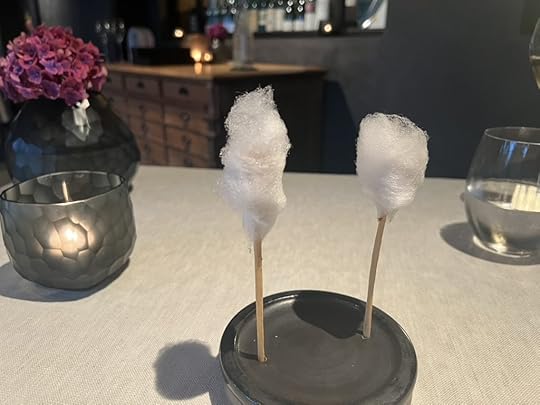
The next aperos displayed rather than hid their complexity.
“Rossini,” a play on tournedos Rossini, combined wagyu tartare, foie gras and Périgord truffle, topped with a dab of caviar.
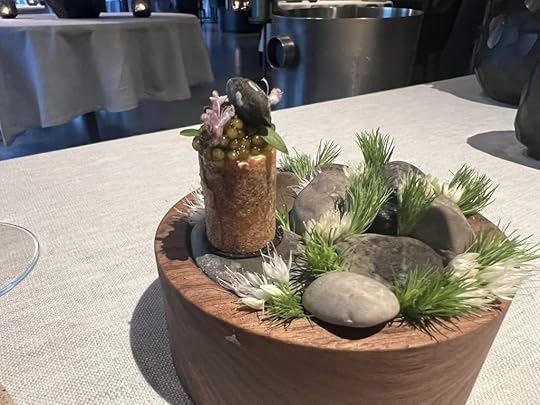
The tartlette was described simply as Breton lobster, lettuce, orange. While a few piquant flowers and leaves added subtle taste and visual notes, the textures and flavors of the main ingredients came through distinctly in the mouth.
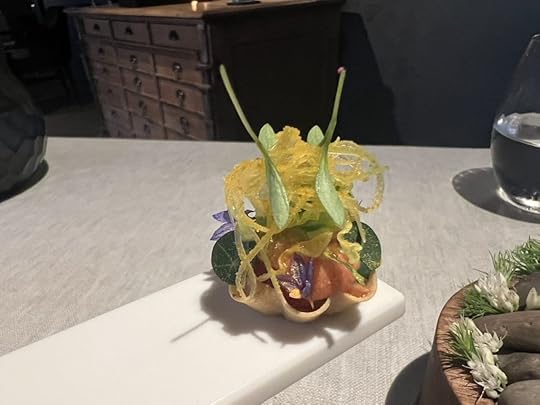
In the macaron, a meringue shell held tartare of local Chiemgau trout topped with an herbal bouquet modestly called mustard pickle. Perfect ingredients perfectly composed, as was the case with each apero.
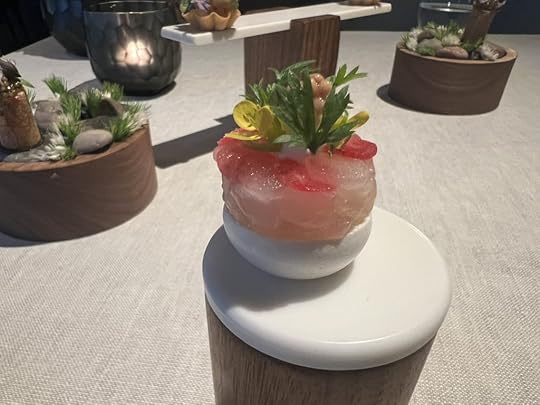
Bread and brioche was listed on the menu as a course of its own, and deservedly so. The house-made breads were truly superlative.
After a few bites I said I would enjoy the bread course as an entire meal. “We take our bread seriously,” the server replied. She then proceeded to drizzle an herbal mustard sauce on the butter plate to enhance the alpine salted butter.
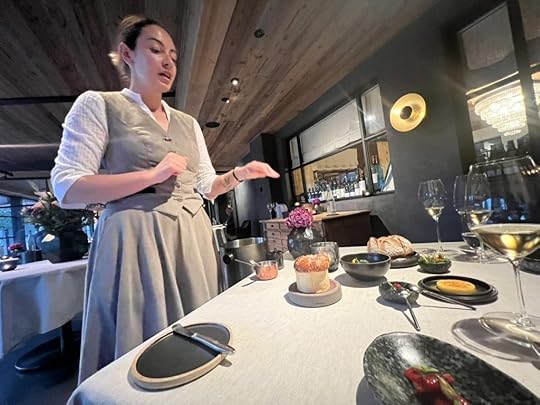
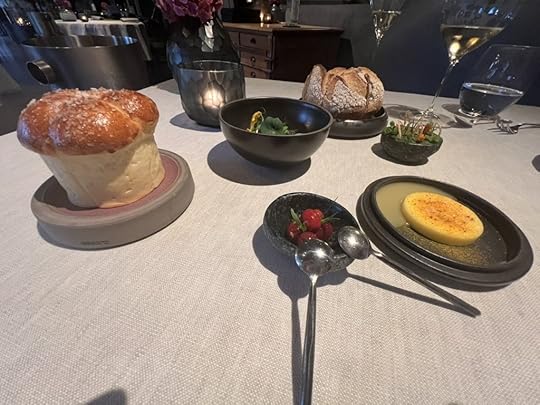
Two other dishes held butter spreads decorated and infused with a “Chiemgau herb garden.”
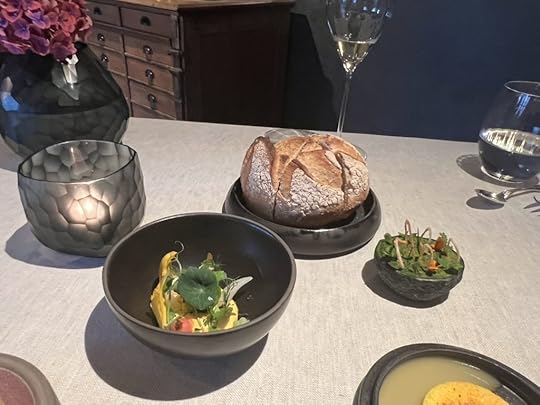
The bread and butter course sets a very high bar for bread servings in any other top restaurant.
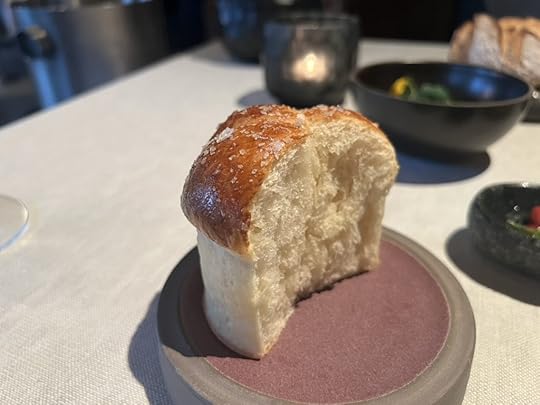
As a further accompaniment for the bread, they served a dish of pointed peppers with wild garlic bud, homemade cream cheese and chardonnay vinegar.
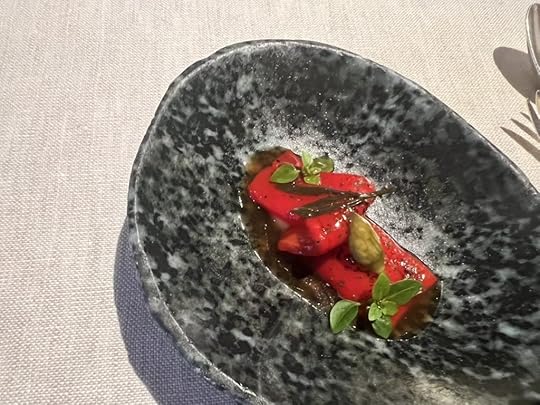
After all this, we hadn’t even had the amuse bouches yet. The two actual amuse bouches came next, one of pike perch and the other called fried chicken. The Chiemsee pike perch (zander), lightly marinated, sat in an herbal broth of elderflower, rhubarb and radish oil.
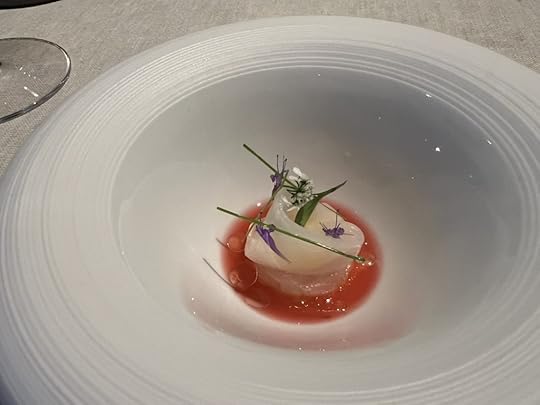
The “fried chicken” amuse was a little masterpiece. Topped with Périgord truffle and N25 caviar, a crispy moist morsel of fried chicken came with a miniature bowl of perfectly reduced chicken broth.
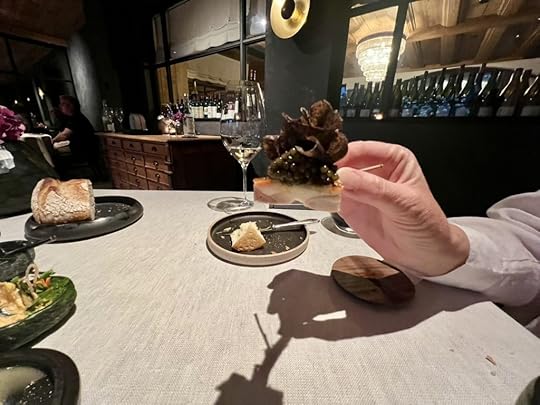
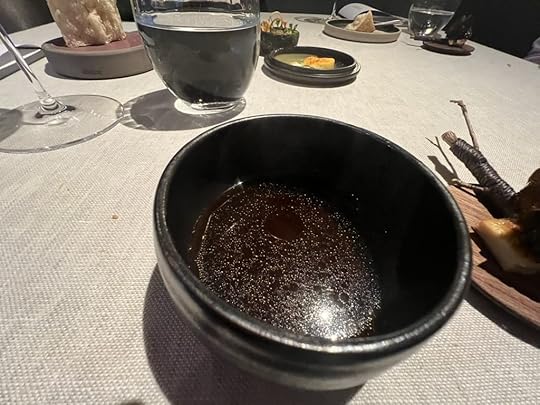
We were then invited to choose between two menus, the six-course Chiemgau Pur, consisting of only ingredients from the immediate local area around Chiemsee, and Chiemgau Goes Around the World, eight courses inspired by Chef Sigl’s travels. I picked the Around the World and Jenna picked the Chiemgau Pur. I thought that would facilitate this review, but we each liked our dishes so much that we were reluctant or downright unwilling to share them!
Around the World began with Hamachi / N25 caviar / leek oil / eggplant / lemon grass. It was an opening statement from the chef that he embraces ingredients that were truly from “around the world.” Unctuous Japanese hamachi topped with Chinese-raised caviar (N25 has become the go-to caviar in many top restaurants) was a decadently delicious combination.
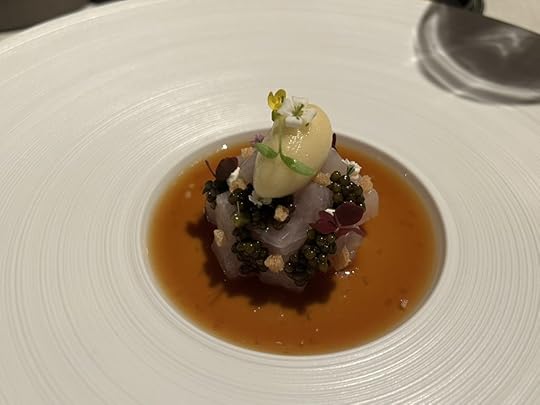
Chiemgau Pur’s first dish was Chiemsee whitefish / anise / dill vinaigrette / cucumber / celery. Every ingredient seemed chosen to emphasize the bright, clean freshness of the fish with bracing notes. Whitefish is a small fish caught in the nearby Chiemsee, the biggest lake in Bavaria. It is a regional favorite for its sweet flaky white flesh.
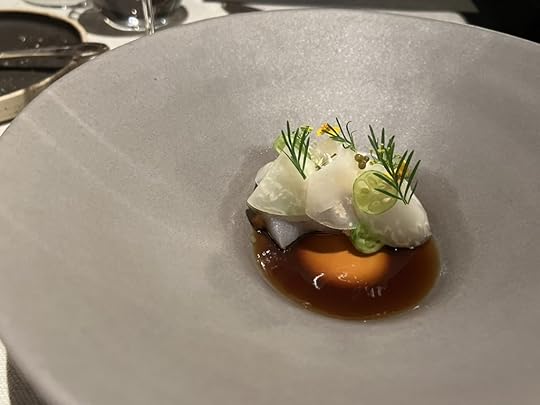
Next on the Around the World menu came Langostino / lettuce / green almonds / piment d’espellette / bisque. It came in three portions:
The tail of the langostino sat in its excellent piment d’espellette sauce. If better langoustines exist, I have yet to taste one.As was the case with many of the dishes, the server left an extra little container of the sauce on the table. And as was the case with many dishes, we used a lot of it. In texture and flavor, each was a textbook example of the ideal of that sauce.
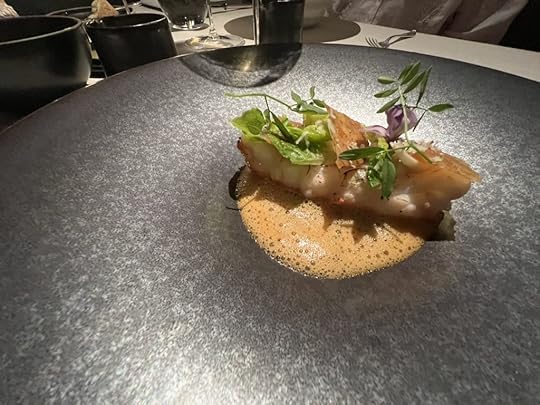
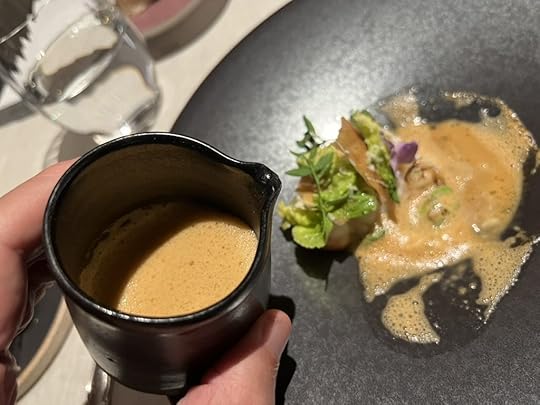 The superb langostino bisque—velvety smooth and deeply flavorful—was enhanced with trout roe and droplets of a concentrated herbal oil (I think it was dill.)The claw, clearly from a very large langoustine, had a sweet and smoky glaze that underscored the tenderness of the meat.
The superb langostino bisque—velvety smooth and deeply flavorful—was enhanced with trout roe and droplets of a concentrated herbal oil (I think it was dill.)The claw, clearly from a very large langoustine, had a sweet and smoky glaze that underscored the tenderness of the meat.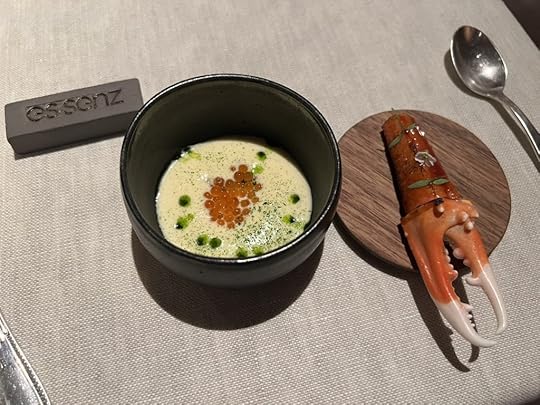
Next on Chiemgau Pur was Crayfish /beans / chanterelles / tomato / sherry. I can’t comment on it because after one taste, my companion, swooning with a smile of satisfaction, refused to share it.
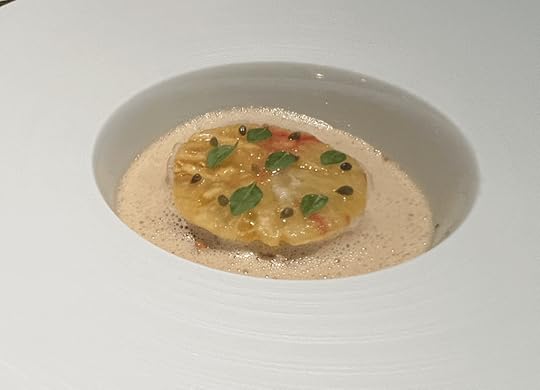
Around the World featured next “Cataplana” / plaice / cuttlefish / tomato / Tagglasca olive. It aimed to raise cataplana, a humble Portuguese seafood stew, to a higher level and succeeded elegantly. It would be repetitive to say that each ingredient was the best of its kind and perfectly cooked, as that was true of every item of every dish.
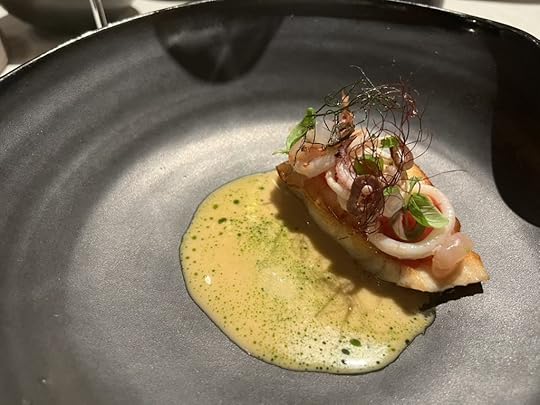
Chiemgau Pur’s next offering was Char by Thalhammer Mühle / sorrel / bacon / white pepper. Each of these three added a sublimely appropriate nuance to the excellent piece of char caught that day in Chiemsee.
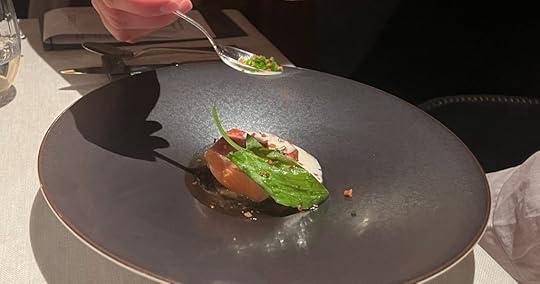
A Bresse pigeon came next on Around the World, beautifully presented on a bed of aromatic leaves and flowers.
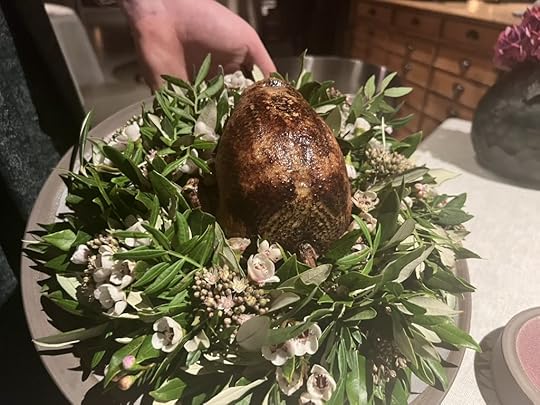
Then the breast and leg were individually served, each separately cooked and differently seasoned, sauced and glazed, accompanied by beetroot, porcini, herb hollandaise and Périgord truffle.
Bresse pigeons, like their chickens, are first raised free-range for a few months, feeding on local plants and insects, and then finished on a diet of grain and milk. The resulting birds are both more flavorful and more tender than others. This was evident in the inherent quality of Es:senz’s pigeon.
On top of that, the loving care given to its cooking is clear to see in these pictures. The glaze of the leg was smokier and more barbecue-like than that of the breast. In both pieces, the flavor and texture of the exterior contrasted beautifully with the tenderness and gaminess of the meat. I have never enjoyed a pigeon dish more than this one.
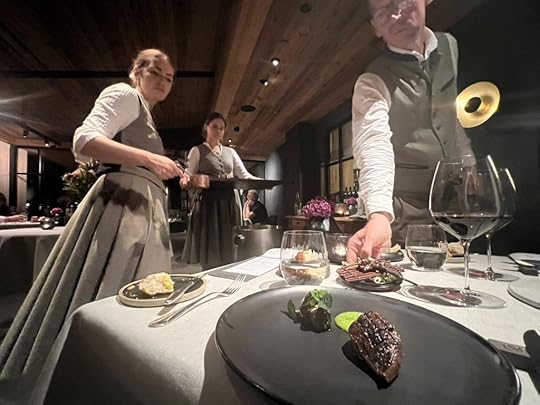
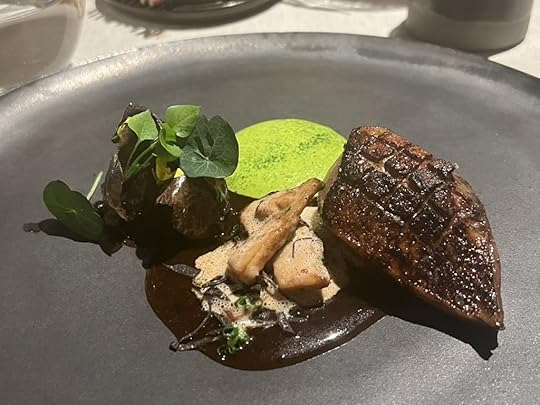
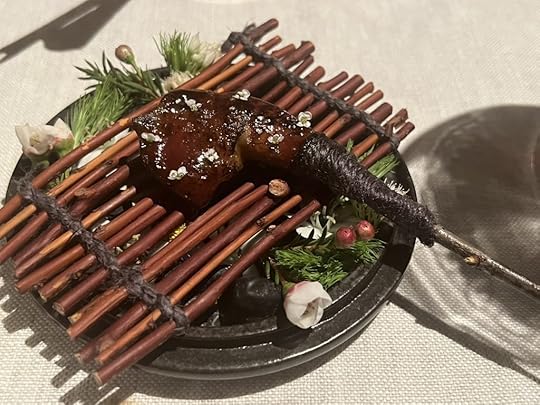
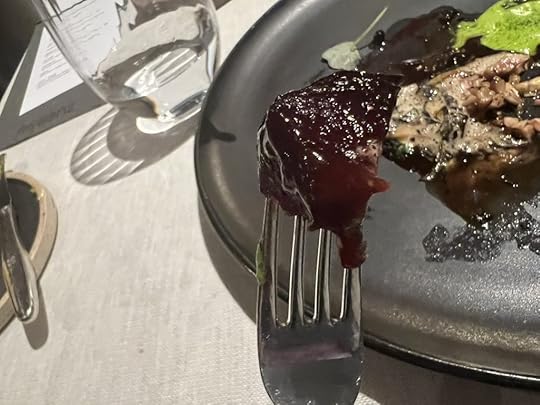
While I was enjoying the pigeon, my companion’s Chiemgau Pur gave her Szegediner: Achental wagyu / pointed pepper / sauerkraut. Just as the cataplana dish raised a humble and distinctively seasoned stew to a higher level, the szegediner dish appeared to similarly elevate that paprika-based Hungarian stew.
However much I went on about how good the pigeon was, she said she did not feel a bit jealous. While I didn’t get to taste it, I was struck by how each ingredient of the szegediner dish was positioned on the plate to be eaten for maximum enjoyment while simultaneously making a beautiful visual composition. As with every dish that Chef Sigl prepared, no ingredient was just for show, yet all were visually striking.
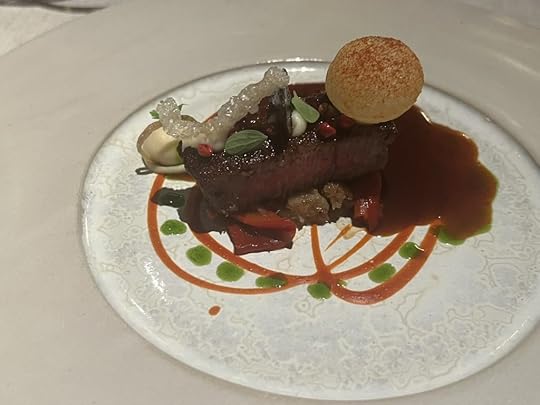
My next dish was a cheese course: Epoisses / pineapple / garlic bread / 20 year old balsamic vinegar. It was excellent for what it was, but I found its flavors too intense to fully enjoy after the delicateness of the pigeon.
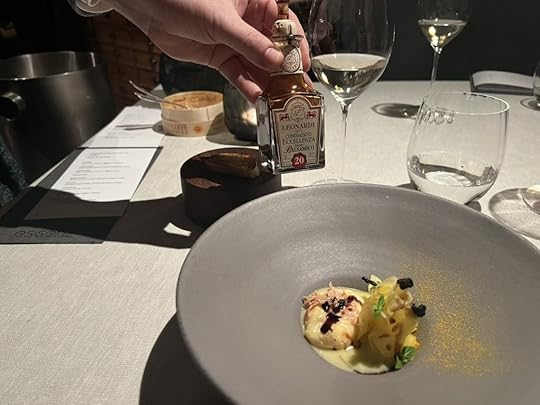
It was time for dessert. Chiemgau Pur transitioned into the sweet courses with Beetroot: goat cheese / yogurt / hazelnut. I didn’t taste it, but Jenna loved it.
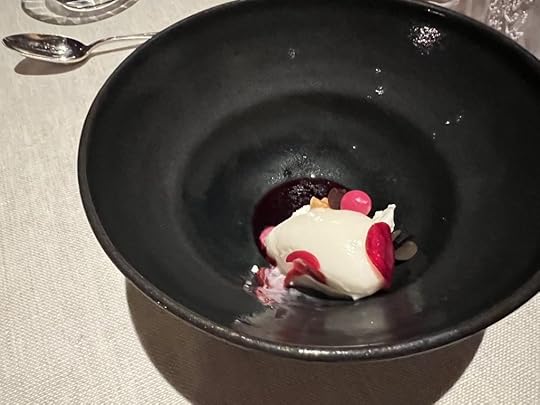
Around the World’s first sweet course was Saffron Ice / fermented rose hips /pumpkin seed oil. Why have I never had saffron ice cream before? Clearly because it takes a lot of expensive saffron to give the intensity of flavor that this one has. But if it weren’t for the cost, saffron would be right up there with pistaccio as a classic ice cream flavor. And this one was– unsurprisingly after the perfection of each of the savory courses– superbly made. The fermented rose hips gave just a hint of a contrasting flavor.
Pumpkin seed oil is an indespensible ingredient in Bavaria and Austria’s Styria. It is one of the essential flavors of the region, used in everything from scrambled eggs to salads to desserts. A local might have found it comfortingly familiar with the exoticness of saffron. Crowned by the finely crafted sugar spiral, this was a masterful dessert.
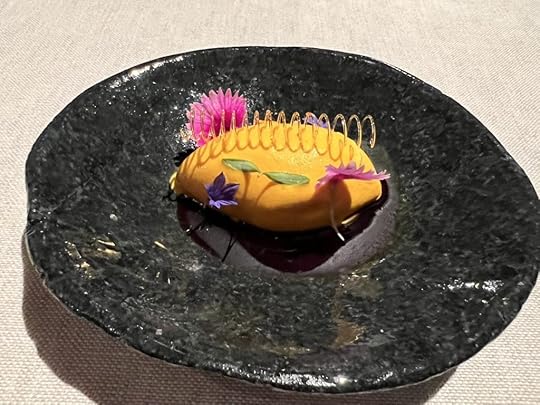
I didn’t get to taste Chiemgau Pur’s next dessert, Apricot / milk / nut butter / amaretto / pumpkin seed oil. It was certainly beautiful on the plate. Apricots are well loved in the Chiemgau region and the nearby Wachau valley. They are grown to give the pleasure that this fruit can provide but never does in commercially available varieties. There are even apricot festivals in the area. Together with the pumpkin seed oil, this combined two local classic flavors into a lovely looking dessert.
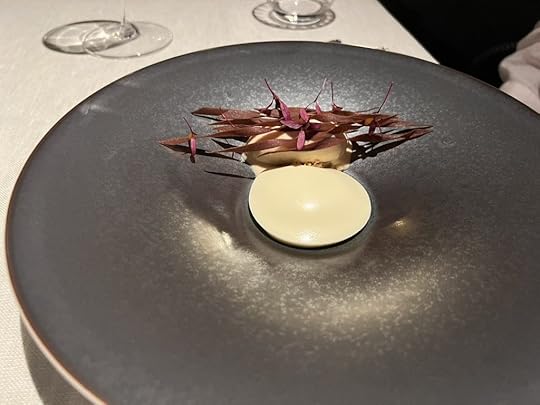
Around the World’s final dessert was Exotic / passionfruit / mango / ginger / coconut. All those things are exotic to Bavarians. To us residents of Kauai, they’re as familiar as pumpkin seed oil is to them. It was yet another beautiful and delicious composition.
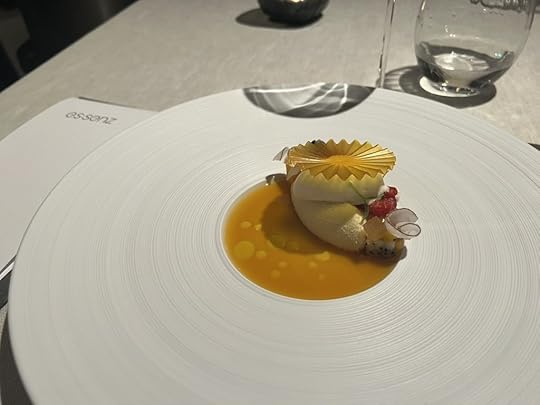
The two menus converged with the petit fours. They were much more than the mere afterthoughts that such little after-dinner treats often are. Each combined the same excellence of ingredients, preparation and presentation as the rest of the meal. And as was the case with the rest of the dishes, each was modestly under-described on the menu:
Homemade pralines, lemon, apple pie, nut acorn, Aperol spicy ginger, toffifee.
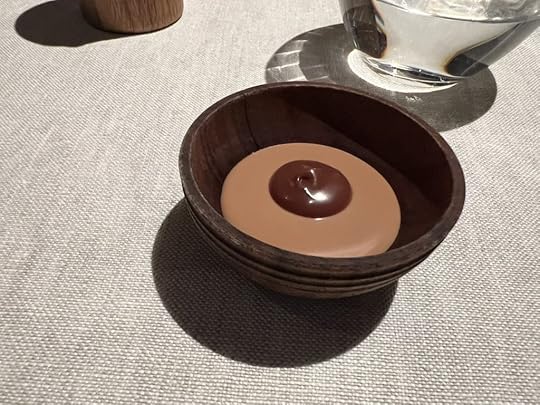
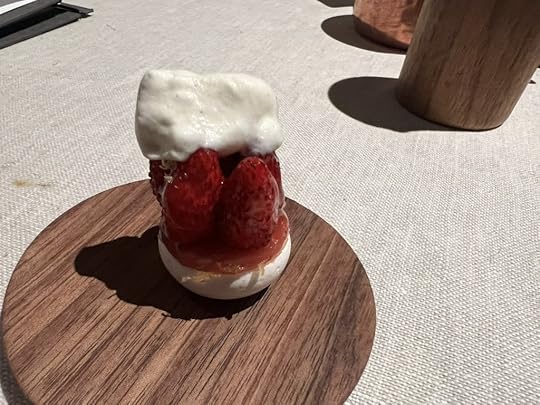
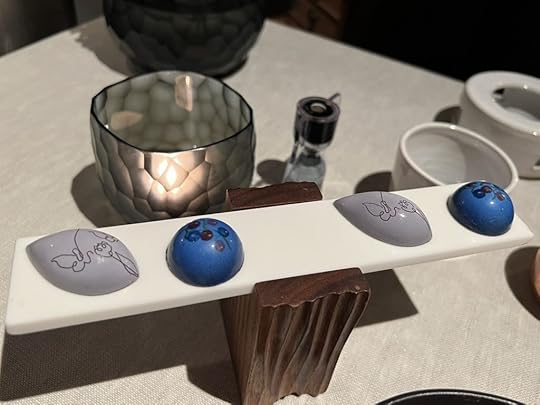
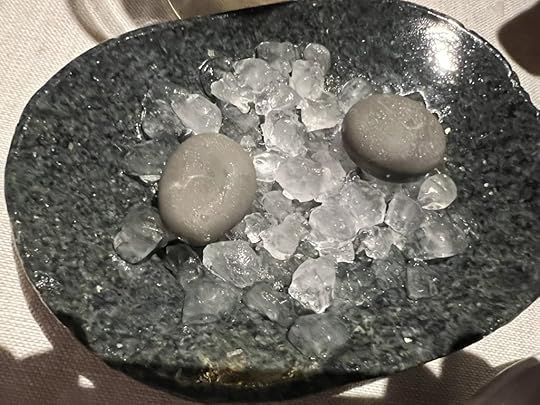
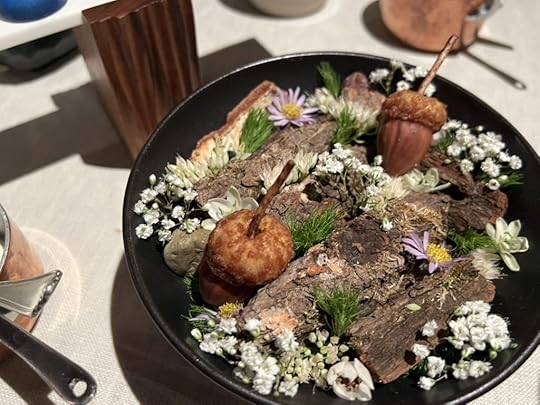
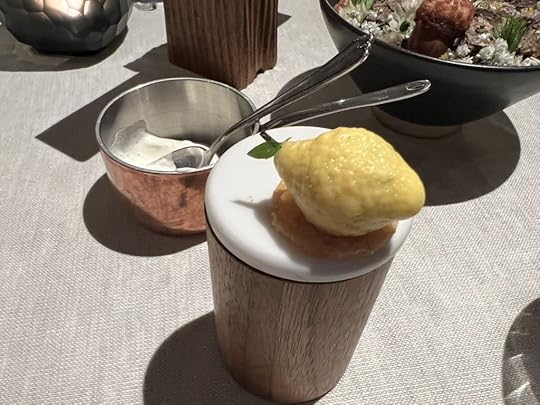
I’ll talk a little now about the wine. I really enjoyed Es:senz’s sommelier. Many in his profession are knowledgeable, but sometimes they slip into a rehearsed spiel about each wine. Es:senze’s sommelier was, in contrast, conversational, personal, and sincerely interactive. “How would you compare this Alsace pinot gris with Zind Humbrecht’s?” I’d ask, for example. “Oh, I like Zind Humbrecht too,” he’d say. “I think this one is just as nuanced but perhaps a bit more elegant,” We then might have a little conversation about one or two under-rated but interesting wines. He seemed to enjoy it as if he were talking with a friend.
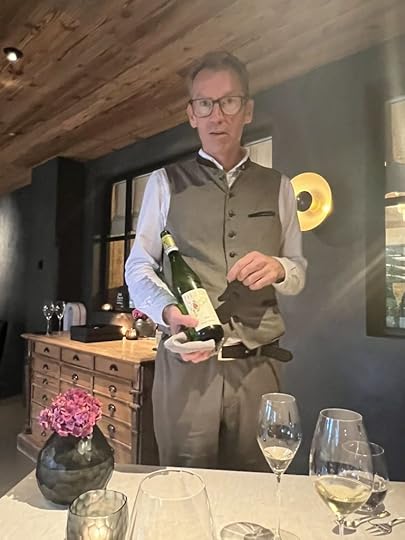
There was of course a pre-planned list of wines for the pairing, but he sometimes deviated from this based on our interests and preferences. Uncommon and much appreciated!
Here are a few of the more interesting wines that he shared for the two different menus we had.
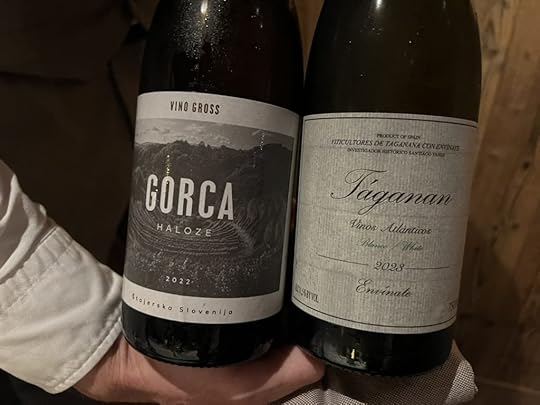
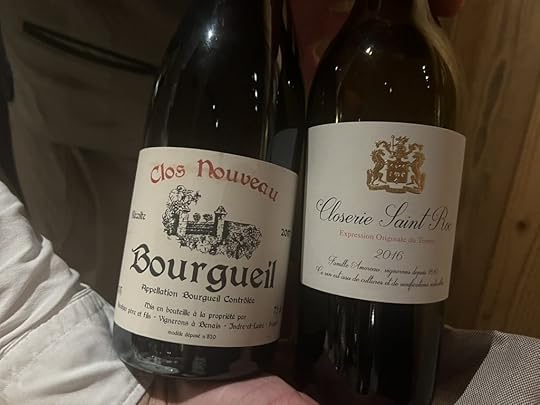
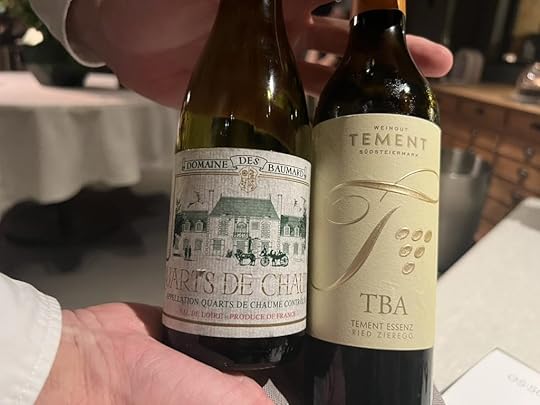
By the way, the name Es:senz is as carefully crafted as its dishes. I chatted with chef Edip Sigl after dinner and he explained it. E and S are his initials, so the name means Edip Sigl’s sense. Essenz also implies getting to the essence of each ingredient. And essen, of course, means to eat in German.
To achieve the goal of getting to the essence of each ingredient, Edip insists on using no extraneous components. Every dish contains the minimum number of ingredients, with each of them serving a clear role and each providing a clearly discernible taste experience. This is in marked contrast to many of even the most highly regarded restaurants which tend to overcomplicate dishes. For me, this rigorous simplicity was the key to the pleasure that each of Edip’s courses gave.
I’d also mention that Edip prepares all this with a surprisingly small kitchen staff. “Your saucier is a maestro,” I said. “Actually, I make all the sauces by myself. I love doing it too much to share that job with anyone else,” he said.
It takes a lot to stand out among Michelin three-star restaurants. Es:senz definitely does. Three stars is supposed to mean worth a journey. This one absolutely is.
Vedat Milor's Blog
- Vedat Milor's profile
- 23 followers



